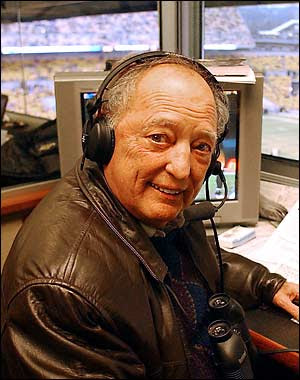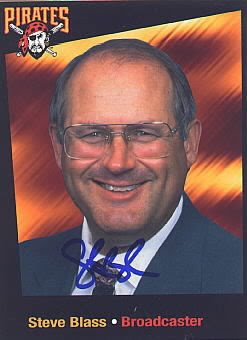Published: Wednesday, February 27, 2008 11:52 PM EST

PITTSBURGH — Throughout the Steelers Nation, Terrible Towels are flying at half mast.
Everywhere we turn, those who knew Myron Cope are paying tribute to the raspy-voiced sportscaster who, in some way, touched the lives of so many associated in some capacity with the Steelers.
On one hand, it’s a sad time.
A local legend has died.
On the other hand, Cope has left us so many fond memories.
Bill Hillgrove, Cope’s long-time sidekick on Steelers radio broadcasts put it best by saying, “I don’t think Myron would want us hanging our heads. He’d want us to celebrate his life.”
By now, countless Cope stories are being rehashed by those who knew Cope or listened to him in the 35 years he broadcast Steelers games. Even a guy like me, who’s only been The Times’ official Steelers beat writer since 1999, has memories of the man, too.
Like most teenagers growing up in western Pennsylvania, I was an avid Steelers and Pitt fan who always got a kick out of Cope’s antics. For those too young to remember, Cope also got plenty of mileage out of Johnny Majors’ first stint at Pitt that ended with a national championship in 1976.
But by then, Cope had already given the Steelers the Terrible Towel and was just as popular as most of the players.
I had gotten the chance to deal with Cope on several occasions before I started covering the Steelers in ’99. But once I became a regular on the beat, I was fortunate to develop a good friendship with a guy who seemed to have countless friends.
After getting to know Cope, one of the things I admired most about him was his uncanny knack to find time to help all those who needed something from him.
Certainly, Cope was a wealth of information every time I ask him for insight. That typically happened when something significant was happening, like when the Three Rivers Stadium era ended or when Cope retired after the 2004 season or when the Steelers made it to Super Bowl XL.
It was thrill to be able to sit down with Cope for 30 minutes or so and listen to him give his version of so many stories and issues. He knew his football. He had an uncanny memory. He had a great sense of humor. He was a great story teller.
I remember once after I wrote a piece that included a bunch of Cope quotes, a female Steelers fan called me and said she could envision Cope speaking as she read the story.
The first time I actually met Cope was in January of 1980 in Newport Beach, Calif. It was at a party a few days before the Steelers beat the Los Angeles Rams for their fourth Super Bowl victory.
At this function, I brought along my two cousins and a few other friends living in southern California at the time. At one point in the evening, we got to talking with Cope, and immediately he befriended us.
Before long, we bought him a cocktail or two. Not long after that, my cousins and friends were picking up Cope and passing him around like he was body surfing at a rock n’ roll concert.
As Cope was being tossed about, he kept yelling, “I love you guys! I love you guys!”
No, Myron.
We loved you.
Everyone loved Myron.
Mike Bires can be reached online at mbires@timesonline.com.
Steelers broadcasting legend Myron Cope dies
By Mike Bires, Beaver County Times Sports Staff
Published: Wednesday, February 27, 2008 10:06 PM EST

Clif Page photo 10/31/2005
Steelers vs. Ravens Former Steeler radio broadcaster Myron Cope before the game.
PITTSBURGH — On a cold, wintry night in December of 1976, Myron Cope made good on a promise and jumped into the icy Monongahela River.
At that stage of his career, Cope was fast becoming a legend throughout all corners of Steelers Nation. A diminutive man of 5-foot-4 with a shrill, raspy voice, he captivated listeners on the team’s radio broadcasts with a unique and entertaining style.
But on this particular evening in ’76, Cope proved that he was also a man of integrity.
For the Steelers to make the playoffs that year, they needed Oakland to beat Cincinnati in a regular-season ending Monday night game. So Cope vowed, “If the Raiders beat the Bengals, I’ll swim the Mon.”
The Raiders, who had already clinched the playoff berth with a 13-1 record, had nothing to gain by beating the Bengals. But Oakland still went out and won, thus eliminating Cincinnati and allowing Pittsburgh to clinch a playoff spot.
So a few days later, Cope donned a wet suit and goggles and arranged for a camera crew from WTAE-TV to drop him off right in the middle in the Monongahela.
“I had not announced the date or time lest I create a traffic jam along the shore that would plunge the police department into a fit of rage,” Cope wrote in his “Double Yoi!” autobiography. “But Channel 4 would have film in time for the 11 o’clock news.”
Memories such as that are being rekindled throughout Steelers Nation since Cope died Wednesday at a Mount Lebanon nursing home after a long bout with respiratory problems and heart failure. He was 79.
Even though he didn’t turn to broadcasting until he was 40 — he was a renowned print journalist before that — he served as the Steelers’ color analyst from 1970 to 2004. That’s the longest run in NFL history for a broadcaster with the same team.
Known for his quick wit and quirky phrases, Cope is the guy credited with first using the term “Immaculate Reception” to describe Franco Harris’ historic game-winning touchdown catch in the Steelers’ 13-7 playoff win over the Raiders in 1972. He’s the guy who, before a 1975 playoff game, introduced the “Terrible Towel,” a lasting symbol of the Steelers’ proud tradition
“Myron was Pittsburgh,” former Steelers running back Rocky Bleier said. “He is somebody all Pittsburghers claim as one of our own. He’s a guy who will always be remembered in the Steelers Nation.
“Over the years, very few people could talk about Myron without imitating that voice of his. People would watch Steelers games on TV with the sound off so they could turn on the radio and get the full flavor of the game the way Myron would present it. His stories will always be part of us.”
Born on Jan. 23, 1929, as Myron Sydney Kopelman, Cope was a graduate of Allderdice High School in Squirrel Hill and the University of Pittsburgh.
He landed his first job writing for the Erie Daily News in 1951. He was such a brilliant writer that his story on sportscaster Howard Cosell was named one of the top 50 stories in Sports Illustrated’s 50th anniversary edition, which went to press in 2004.
But Cope’s life took a strange twist in 1968 when WTAE-AM radio hired him as a morning sports commentator. Two years later, he broadcast his first Steelers game.
From that point, Cope would become the conduit between the Steelers and their fans.
“Myron brought Steelers football closer to the fans,” team president Art Rooney II said. “More than any one person, he just made the fans feel part of it. Not just with the Terrible Towel, which was a big part of it. But his personality and the enthusiasm he brought to the broadcast, it was unique to say the least and made for a very special time.
“His memorable voice and unique broadcasting style became synonymous with Steelers football. They say imitation is the greatest form of flattery, and no Pittsburgh broadcaster was impersonated more than Myron.”
Mike Bires can be reached at mbires@timesonline.com.




















